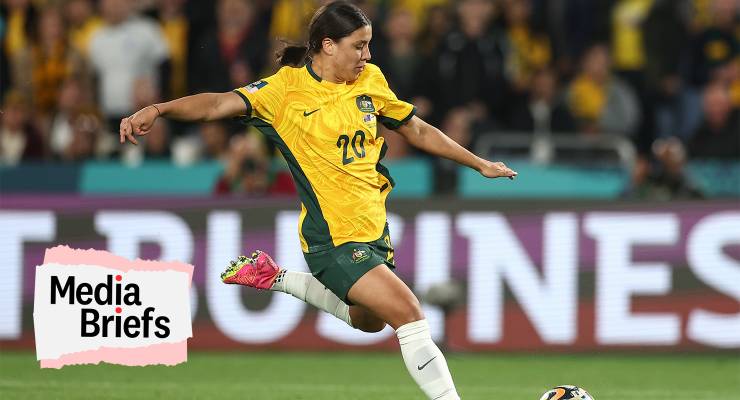
The Matildas’ Women’s World Cup semi-final loss to England on Wednesday night drew more than 7 million free-to-air viewers, the largest audience recorded since records began in 2001.
According to early figures from Seven and OzTAM, the game drew a national average audience of 7.13 million viewers on Seven and 7plus. The total figure, however, is likely much higher given OzTAM doesn’t track out-of-home viewing at pubs, clubs and other venues where tens of thousands of fans gathered to watch the match.
Seven drew a national broadcast audience of 6.17 million, the network said, with 4.5 million tuning in from capital cities, and another 957,000 viewers streaming the match on 7plus, making the semi-final match the most-streamed event in Australian history.
All in, Seven’s coverage of the 2023 FIFA Women’s World Cup has reached 14.04 million broadcast viewers so far, the network said on Thursday morning, plus a further 3.4 million viewers on 7plus. But the ratings dominance hasn’t quite translated to commercial success for the network, which on Wednesday reported an 18.2% profit slide amid a tough TV advertising market.
Speaking at a presentation of Seven West’s full-year results on Wednesday, chief executive James Warburton said ad blackouts enforced during play meant the network wasn’t able to fully capitalise on its record-breaking audiences.
“The thing with the Women’s World Cup is that you’ve got to remember the audience has been absolutely unbelievable and we’ve loved telling the narrative of this wonderful team — and go Matildas tonight and hopefully all the way on Sunday — but there’s no ads during … play, during extra time, during penalty shootout, so it’s quite limited in terms of its commerciality,” he said.
Seven secured the rights to the Women’s World Cup for less than $5 million as the free-to-air partner of Optus Sport, which The Australian Financial Review reported in 2021 secured the competition’s exclusive broadcast rights for about $13 million.
The tournament, however, has been a boon for the corporate news media, where coverage of the tournament has driven a significant uplift in readership. At News Corp Australia, the Women’s World Cup has been a major win for news.com.au, which the company said saw a traffic uptick of 90% through the Matildas’ quarter-final match against France, compared to that seen during the team’s first match against Ireland.
News Corp said the company’s “other sites” are also seeing increased traffic, including an “incremental” 2.86 million page views shared by digital editions of regional- and state-based mastheads over the past five weeks, such as The Daily Telegraph and the Herald Sun, which were on Wednesday printed under the monikers The Daily Tillygraph and the Herald Sam respectively.
On a global level, The Guardian said on Wednesday that it had produced “over 400 articles” on the Women’s World Cup, eclipsing the publisher’s volume of tournament coverage in 2019. So far, this year’s coverage has clocked more than 25 million page views.
Just over a third of its readers have come from the UK, shortly followed by the US and Canada, which have accounted for 24% of readers so far, while Australia and New Zealand traffic for World Cup content alone tripled Guardian Australia’s regular contribution to global traffic, accounting for 21% of readers, a spokesperson told Crikey. Europe, meanwhile, accounted for 14% of global readers, and the 7% balance was made up of readers from the rest of the world.
The day of the quarter-finals, August 12, was The Guardian’s “biggest day for sport” since England’s quarter-final loss to France in the 2022 men’s World Cup, the company said, adding that live-blog coverage of Wednesday’s semi-final drew more than 2 million readers. So far, the Women’s World Cup has driven Guardian Australia’s fourth, fifth and sixth days of sport traffic since 2018, not including Wednesday’s traffic, behind Novak Djokovic’s visa debacle and Shane Warne’s death.
The news
ABC News Online draws ‘vast majority’ of complaints: ombudsman (Crikey)
Foxtel “flagrantly” stole technology from us, small Sydney firm claims (AFR)
What next for Q+A, if not the end? (SMH)
Football Australia chases record TV deal after Matildas’ success (AFR)
News Corp’s lips sealed over absence of Newspoll in lead-up to Voice referendum (Crikey)
Seven West Media embedded with climate protesters before criticising ABC for doing the same (Guardian Australia)
Australian podcast advertising up 64%, Amazon leads spend (Mumbrella)
Seven sets course for an unremarkable decade (Unmade)
Hollywood calls time on golden era of cheap streaming (FT)
Hollywood Studios Offer Writers a New Deal With Push From Netflix, Iger to End Strike (Bloomberg)
CNN overhauls programming schedule, finally solidifies primetime lineup (Axios)
US Ambassador Meets Evan Gershkovich, Detained WSJ Reporter, in Russia (NYT)
New York Times drops out of AI coalition (Semafor)
Inside Canada’s fight with Facebook (Politico)
Crypto Media Company CoinDesk Laying off Staff (WSJ)
Daily Mail owner confirms interest in Telegraph auction (FT)
The moves
- Lisa Visentin will take over as The Sun-Herald’s political correspondent, following Anthony Galloway’s departure from the paper.
- David Koch has landed a plum new job with the comparison site, Compare the Market, as its “economic director”. It’s his first move since he left Sunrise in June.








I was hoping Albanese will announce a national day of mourning after their defeat,
so I was looking forward to a long week-end.
I think Littleproud vetoed it.
My daughter and her mates, on tour in Egypt, held up their tour group while the shoot out happend and then got the Casablanca Irish Pub to open early for last nights game. Big fans.
He will be referred to the Committee for UnAustralian Activities.
https://www.theguardian.com/football/video/2023/aug/13/the-moment-a-plane-full-of-passengers-erupts-over-the-matildas-win-except-one-video
“so it’s quite limited in terms of its commerciality,” Firstly thank you to Channel 7 for the wonderful uninterrupted broadcast, we loved it ..never stop a billionaire from trying to monetize everything. You paid peanuts for the broadcast, you did a wonderful job, and the whole community thanks you.